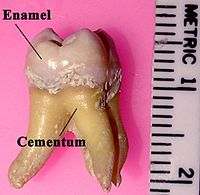
Photo from wikipedia
During orthodontic treatment, enamel demineralization can occur. Its early detection is the basis for efficient preventive measures to arrest or remineralize lesions. In the present study, the application of a… Click to show full abstract
During orthodontic treatment, enamel demineralization can occur. Its early detection is the basis for efficient preventive measures to arrest or remineralize lesions. In the present study, the application of a novel blue hemoglobin-based liquid (BlueCheck) was evaluated as proof of concept for detection of artificially demineralized smooth surfaces. 60 samples from extracted human posterior teeth were randomly assigned to four groups (15 per group). In 30 of these samples (groups A and B), superficial enamel was removed to create a ground surface. On the surface of other 30 samples (group C and D), orthodontic metal brackets were bonded. On each surface, BC liquid was applied and rinsed with water after 3 min (baseline). All surfaces were checked by two independent observers for presence of blue areas. On each sample, one side was covered by nail varnish to protect this enamel part from demineralization. The samples were demineralized with lactic acid (pH 4.6) for 7 days (group A and C) and 14 days (group B and D), respectively. Mineral loss was determined using quantitative light-induced fluorescence after demineralization. BlueCheck dye was again applied on the samples and evaluated for presence of stained areas. Histological sections were prepared from randomly selected samples and lesion depth was measured. Kruskal-Wallis test was used for group comparison (α = 0.05). After demineralization, median ΔF value for all samples was −8.25% indicating the presence of an initial demineralization. The difference of ΔF values was not statistically significant between samples at 7 or 14 days of demineralization, nor for samples with and without orthodontic brackets (p = 0.13). At baseline, none of the sample surfaces showed discoloration, whereas a distinctive blue color was visible after demineralization in all samples exposed to acid-exposed areas, corresponding to 100% sensitivity. The internal control surfaces (without demineralization) did not show any staining, corresponding to 100% specificity. Histologically measured lesion depths ranged between 200 and 254 μm. In this in vitro study, staining of demineralized enamel surface areas were shown to be reliable. Based on our results, this easily applicable product seems useful to be an adjuvant method to clinical examination to monitor oral health during an orthodontic treatment on tooth surfaces after removal of dental biofilm.
Journal Title: Caries Research
Year Published: 2022
Link to full text (if available)
Share on Social Media: Sign Up to like & get
recommendations!